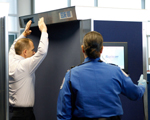|
The growing use
of backscatter X-ray detection
systems at airports to identify
weapons and concealed objects on
travelers and its long-term health
effects from radiation continues
to be debated.
MUSC
radiologist Walter Huda, Ph.D.,
professor in the Department of
Radiology and Radiological
Science, examined international
research and radiology studies and
wrote about it in the February
issue of InPractice Insight, a
monthly journal published by the
American Roentgen Ray Society.
Huda found no evidence that
full-body scans, which emit small
amounts of radiation when used at
airports, are unsafe.
Backscatter
X-ray imaging technology features
body imaging machines that perform
full body scans of airline
passengers to detect objects such
as concealed weapons, explosives,
tools, narcotics and other
contraband. This technology is a
big improvement to metal
detectors, which cannot detect
explosives or nonmetallic weapons.
 The backscatter
X-ray scanner is being used by
many U.S. airports by the
Transportation Security
Administration. The backscatter
X-ray scanner is being used by
many U.S. airports by the
Transportation Security
Administration.
This type of
X-ray imaging system uses ionizing
radiation instead of high-energy
light photons used in standard
X-rays. The backscatter system
picks up images produced when
materials scatter X-ray photons
and are better at imaging organic
material and therefore have the
potential to damage chemical
bonds. The effective dose from a
single scan from a backscatter
X-ray machine delivers about 0.1
micro-Siervert (uSV).
According to
Huda, ionizing radiation is
accepted as being carcinogenic at
high doses, but the existence of
radiation risks at doses below 50
to 100 mSV continues to be
debated. Reasons for the ongoing
debate about radiation risks at
low doses point to the lack of
convincing evidence and the fact
that such risks, if any, are
likely to be small, he said.
In 2010, about 60 backscatter
X-ray scanners were installed in
airports across the country.
Today, more than 500 body scanners
(backscatter and millimeter-wave)
are in use at airports. The
Transportation Security
Administration plans to roll out
additional scanners to airport
security checkpoints by 2014.
At European
Union airports, backscatter X-ray
scanners have been prohibited for
use "in order not to risk
jeopardizing citizens' health and
safety." Instead, EU airports use
millimeter-wave scanners that use
radio frequency waves versus low
levels of ionizing radiation.
To put the
radiation doses from airport
scanners into perspective, people
receive about 1,000 uSV every year
from background sources and many
also will receive about two to
three times this amount from Radon
exposure.
Air crew, such
as pilots and flight attendants,
who spend about 1,000 hours in the
air flying at 30,000 feet, also
receive an additional annual
exposure of about 5,000 uSV.
According to Huda, it is evident
that the additional radiation dose
from an airport X-ray scanner is
trivial and irrespective of how
often they fly.
Huda believes
that these backscatter systems do
not pose any hazard to any exposed
individuals.
When it comes
to radiation risks, organizations
such as the National Council on
Radiation Protection and
Measurements (NCRPM), the National
Academy of Sciences in the United
States' Biological Effects of
Ionizing Radiation committee
support that whole body doses of
more than 100 mSv may be harmful.
"It clearly
makes no sense to attempt to make
use of any quantitative radiation
risks at doses of the order of
0.0001 mSv, because these doses
are six orders of magnitude lower
than the carcinogenic risks of
radiation exposure that are
generally accepted by most of the
scientific community." Huda said.
Huda reports
that other scientific bodies and
organizations regard any radiation
concerns from backscatter X-ray
machines to be of no practical
importance. The NCRPM, the Healthy
Physics Society and American
College of Radiology have stated
that there is no specific evidence
that full-body scan are unsafe.
The UK Health Protection Agency
has written that the dose is
extremely low and the European
Commission reports that the
backscatter X-ray system poses no
known health risk.
"Whether
backscatter X-ray machines should
be introduced to screen passengers
is a political decision that will
need to be addressed along with
other issues including an analysis
of costs and benefits as well as
considering other alternative
technologies," Huda said.
To read the
story, visit http://www.arrs.org/Templates/TemplateIP_1col.aspx?id=2167.
|



 The backscatter
X-ray scanner is being used by
many U.S. airports by the
Transportation Security
Administration.
The backscatter
X-ray scanner is being used by
many U.S. airports by the
Transportation Security
Administration.